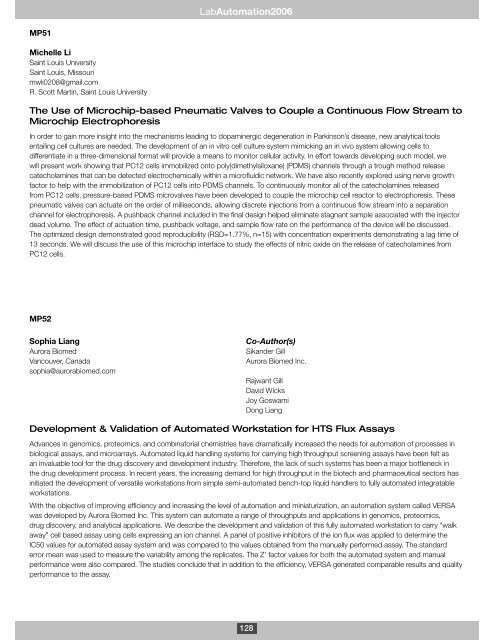LabAutomation 2006 - SLAS
LabAutomation 2006 - SLAS
LabAutomation 2006 - SLAS
Create successful ePaper yourself
Turn your PDF publications into a flip-book with our unique Google optimized e-Paper software.
MP51<br />
Michelle Li<br />
Saint Louis University<br />
Saint Louis, Missouri<br />
mwli0208@gmail.com<br />
R. Scott Martin, Saint Louis University<br />
<strong>LabAutomation</strong><strong>2006</strong><br />
The Use of Microchip-based Pneumatic Valves to Couple a Continuous Flow Stream to<br />
Microchip Electrophoresis<br />
In order to gain more insight into the mechanisms leading to dopaminergic degeneration in Parkinson’s disease, new analytical tools<br />
entailing cell cultures are needed. The development of an in vitro cell culture system mimicking an in vivo system allowing cells to<br />
differentiate in a three-dimensional format will provide a means to monitor cellular activity. In effort towards developing such model, we<br />
will present work showing that PC12 cells immobilized onto poly(dimethylsiloxane) (PDMS) channels through a trough method release<br />
catecholamines that can be detected electrochemically within a microfluidic network. We have also recently explored using nerve growth<br />
factor to help with the immobilization of PC12 cells into PDMS channels. To continuously monitor all of the catecholamines released<br />
from PC12 cells, pressure-based PDMS microvalves have been developed to couple the microchip cell reactor to electrophoresis. These<br />
pneumatic valves can actuate on the order of milliseconds, allowing discrete injections from a continuous flow stream into a separation<br />
channel for electrophoresis. A pushback channel included in the final design helped eliminate stagnant sample associated with the injector<br />
dead volume. The effect of actuation time, pushback voltage, and sample flow rate on the performance of the device will be discussed.<br />
The optimized design demonstrated good reproducibility (RSD=1.77%, n=15) with concentration experiments demonstrating a lag time of<br />
13 seconds. We will discuss the use of this microchip interface to study the effects of nitric oxide on the release of catecholamines from<br />
PC12 cells.<br />
MP52<br />
Sophia Liang<br />
Aurora Biomed<br />
Vancouver, Canada<br />
sophia@aurorabiomed.com<br />
Co-Author(s)<br />
Sikander Gill<br />
Aurora Biomed Inc.<br />
Rajwant Gill<br />
David Wicks<br />
Joy Goswami<br />
Dong Liang<br />
Development & Validation of Automated Workstation for HTS Flux Assays<br />
Advances in genomics, proteomics, and combinatorial chemistries have dramatically increased the needs for automation of processes in<br />
biological assays, and microarrays. Automated liquid handling systems for carrying high throughput screening assays have been felt as<br />
an invaluable tool for the drug discovery and development industry. Therefore, the lack of such systems has been a major bottleneck in<br />
the drug development process. In recent years, the increasing demand for high throughput in the biotech and pharmaceutical sectors has<br />
initiated the development of versatile workstations from simple semi-automated bench-top liquid handlers to fully automated integratable<br />
workstations.<br />
With the objective of improving efficiency and increasing the level of automation and miniaturization, an automation system called VERSA<br />
was developed by Aurora Biomed Inc. This system can automate a range of throughputs and applications in genomics, proteomics,<br />
drug discovery, and analytical applications. We describe the development and validation of this fully automated workstation to carry “walk<br />
away” cell based assay using cells expressing an ion channel. A panel of positive inhibitors of the ion flux was applied to determine the<br />
IC50 values for automated assay system and was compared to the values obtained from the manually performed assay. The standard<br />
error mean was used to measure the variability among the replicates. The Z’ factor values for both the automated system and manual<br />
performance were also compared. The studies conclude that in addition to the efficiency, VERSA generated comparable results and quality<br />
performance to the assay.<br />
128
















